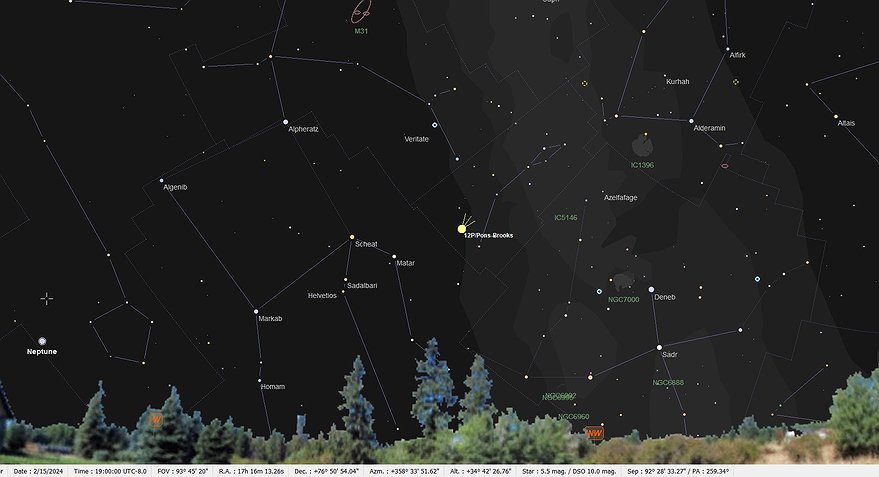Best night sky events for February 2024
Don’t forget that this February brings a Leap Day! Since it takes 365.25 days for Earth to orbit the sun, our calendar needs to make up for a quarter of day each year.
Feb. 2, 15:18 — Last quarter moon
The last quarter moon is the third and final quarter phase of the moon during its monthly cycle. At this point, the moon appears half-illuminated, with the left half visible from the Northern Hemisphere and the right half visible from the Southern Hemisphere. This moon is visible after midnight and throughout the morning.
Feb. 9, 15:00 — New moon
The new moon is the beginning of the lunar cycle when the moon is not visible from Earth. It occurs when the moon is positioned between the earth and the sun. Since the illuminated side of the moon is facing away from us, the night sky will be especially dark, making it an excellent time for stargazing without moonlight interference.
Feb. 11-13 — The crescent moon smiles!
Typically, the crescent moon looks like an archer’s bow, but for these special few days, the moon appears to smile in the fading twilight. Make time to head out and see it … and let it bring a smile to your face!
Feb. 14, 22:15 — Jupiter 2.3° S of moon
An inexpensive Valentine’s present — Jupiter, the largest planet in our solar system, will be about 2.3 degrees south of the moon on this date and time. It will be a wonderful sight to observe these two prominent celestial objects in the same part of the sky.
Feb. 11-15, 19:00 — Look for comet Pons-Brooks
12P/Pons-Brooks is a periodic comet with an orbital period of 71 years. It fits the classical definition of a Halley-type comet and is also one of the brightest known periodic comets, reaching an absolute visual magnitude of 5 in its approach to perihelion. Right now Pons-Brooks is around magnitude 8.3 and should be easily found in a pair of 10x50 binoculars. See the accompanying image to find its location.
Feb. 16, 07:01 — First quarter moon
The first quarter moon marks the halfway point between the new moon and the full moon. It appears as a half-illuminated disk with the right half visible from the Northern Hemisphere and the left half visible from the Southern Hemisphere and is visible in the afternoon and evening sky.
Feb. 16, 19:00 — Pleiades 3.0° W of moon
The Pleiades, also known as the Seven Sisters or Messier 45, is a beautiful open star cluster in the constellation Taurus. On this date and time, the Pleiades will be located about 3.0 degrees west of the moon, creating a stunning visual conjunction.
Feb. 20, 20:00 — Pollux 2.2° N of moon
Pollux, one of the brightest stars in the constellation Gemini, will be situated about 1.6 degrees north of the moon on this date and time. The pairing of the moon and Pollux will be an attractive sight in the night sky.
Feb. 24, 06:30 — Full moon
The full moon is the lunar phase when the entire face of the moon is illuminated by the sun and appears as a bright, full disk in the night sky. It is a spectacular sight and is often referred to as the “Snow Moon.”
Feb. 29, 00:00 — Leap day
Feb. 29 is an intercalation date, or the insertion of a day in our calendar. It is used to try to ensure that lunar and solar schedules remain compatible and consistent with the tracking of the seasons.
Julius Caesar ordered this new “Julian” solar calendar and it took effect in 45 B.C. It was based on the math that a year should consist of exactly 365 days and six hours and that every four 365-day years, those extra six hours would total to one extra day that needed to be added to the calendar, but this rule of inserting a leap day every four years still overshot the solar year by 11 minutes, annually.
This discrepancy would accumulate to cause a 10-day difference with the actual solar cycle by the 16th century, leading then Pope Gregory XIII to introduce a new calendar in the 1570s: the Gregorian calendar that we use today, which adjusted the every-four-years rule for leap years to exclude centurials (i.e., 1700, 1800, 1900) except those divisible by 400 (i.e., 1600, 2000, 2400).
According to a Time Magazine article: “It would seem safe to assume that humanity had perfected the art of tracking time by now, but one more adjustment was made beginning in 1972: leap seconds, which help to make up for an ever-so-slight remaining difference between Coordinated Universal Time (UTC), which is based on the Gregorian calendar, and atomic time, which more closely approximates solar time and is slightly faster. But timekeeping is not an exact science — and sometimes it causes so many headaches that experts decide to stop pursuing such precision, such as in 2022, when the world’s foremost metrology body decided to abandon leap seconds altogether by 2035.”
• • •
John Taylor is an amateur astronomer who lives in Hayden.




